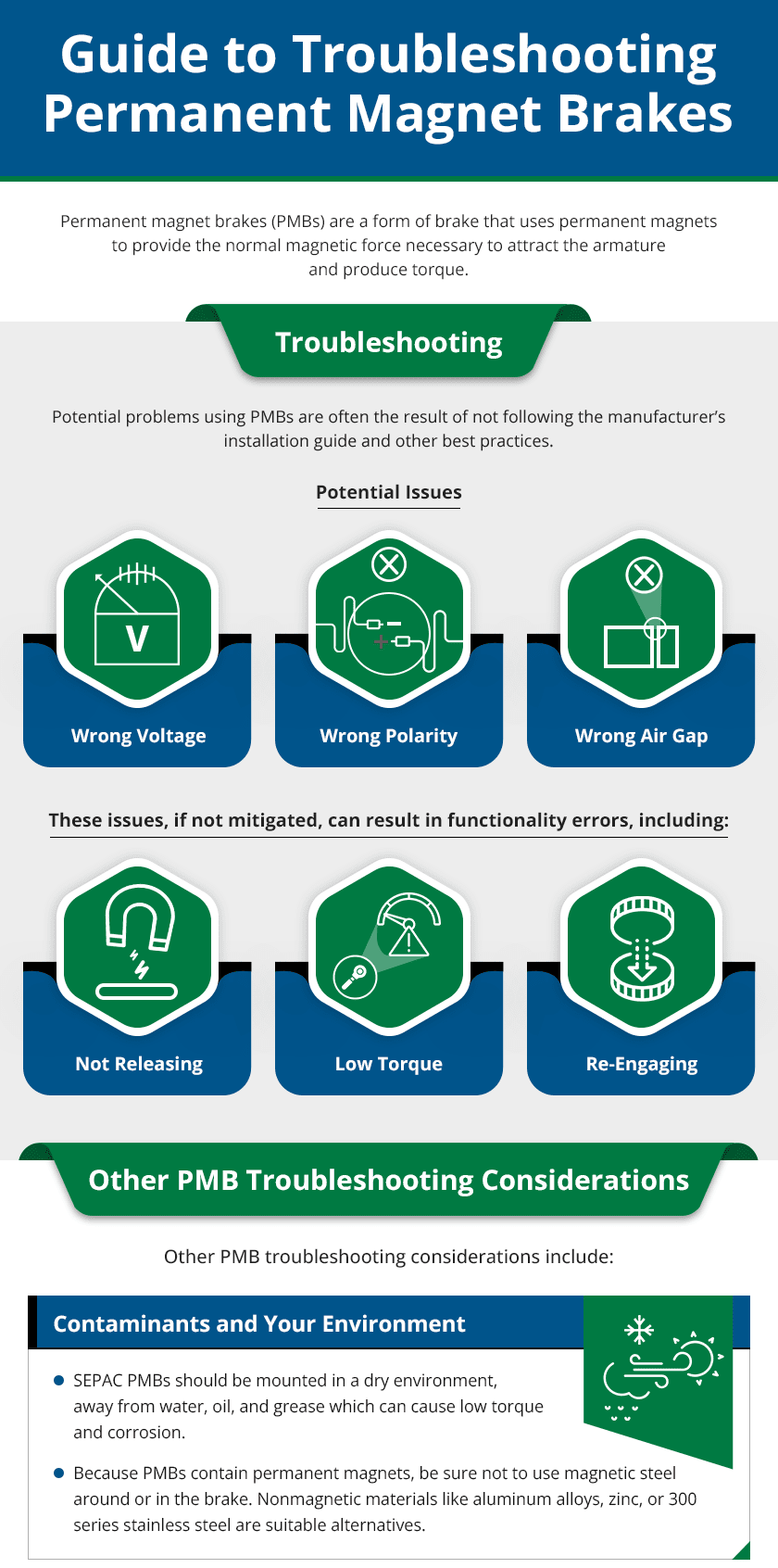The first step in fixing something is to understand how it works. Permanent magnet brakes (PMBs) are a form of brake that uses permanent magnets to provide the normal magnetic force necessary to attract the armature and produce torque.
Permanent magnet brakes are used to hold or stop a load. Also called permanent magnet power off brakes, PMBs use permanent magnets to produce normal magnetic force within the magnet body assembly.
In the absence of DC power, the magnet’s normal force attracts the armature plate and creates torque. When power is supplied, it engages the polarized DC coil in the brake assembly, reversing the magnetic strength within the flux path of the permanent magnet. This reduces the force to zero, and the diaphragm spring releases the armature, releasing the brake.
Troubleshooting
Permanent magnet brakes and spring-engaged brakes perform similar functions but have distinct properties. PMBs can stop dynamically or simply hold a rotating shaft when power is removed. Because PMBs are also lighter and smaller in diameter than spring-engaged brakes vs torque output, PMBs are preferred for applications with weight or space limitations.
Potential problems using PMBs are often the result of not following the manufacturer’s installation guide and other best practices. Some possible issues include:
- Wrong voltage
- Wrong polarity
- Wrong air gap
These issues, if not mitigated, can result in functionality errors, including:
- Not releasing
- Low torque
- Re-engaging
Other PMB troubleshooting considerations include:
Contaminants and Your Environment
SEPAC permanent magnet brakes should be mounted in a dry environment, away from contaminants like water, oil, and grease. This ensures that the brakes can function correctly. Oil or grease can lower the friction force, lowering the torque capability. Also, water can cause corrosion, which can lead to low torque or even a loss of torque.
Permanent magnet brakes should be piloted on the inner diameter (ID) of the magnet body or outside of the mounting flange.
Because PMBs contain permanent magnets, be sure not to use magnetic steel around or in the brake. Nonmagnetic materials like aluminum alloys, zinc, or 300 series stainless steel are suitable alternatives. If you must use magnetic steels, make sure to leave at least a 0.25” gap around the field of the brake.
Mounting
Improper mounting could also result in poor PMB performance. Here are some tips for troubleshooting mounting issues:
- Mounting Interface: The shaft should be perpendicular to the mounting surface within 0.005” total indicator reading (TIR). Mounting surfaces should be level and perpendicular to the shaft within 0.002”. If not, it can result in surfaces being hit or struck when power is supplied.
- Supply Voltage: The supplied voltage should change no more than ±10%. The brake may not release if the voltage isn’t between 21.6 and 26.4 V. The positive electrode is marked red, and the negative electrode is marked black. If the polarity is wrong, the brake may not operate.
- Power & Current: Use only direct current or full-wave rectified direct current. A DC PWM can be used as well. The Brakes will not function with alternating current (AC) applied.
SEPAC ships brakes without burnishing or run-in. This means you may have to manually turn it a few revolutions to obtain the proper torque.
Electrical Connections
Electrical connections refer to the wiring between the brake’s magnetic coil and DC power supply. Make sure the polarity is correct. The red wire should go to the positive terminal, while the black wire goes to the negative terminal. Control switching should be in the DC circuit, as AC circuit switching can cause slow disengagement. All circuits should be using arc suppressors.
Air Gap Set at Assembly
If your PMB is not releasing when you apply power or not engaging when you remove power, you could be dealing with an improperly set air gap. See the below table for specific air gaps by brake model size:
| Model | Air Gap Set at Assembly | |||
|---|---|---|---|---|
| Min. | Max. | |||
| MM | Inches | MM | Inches | |
| PMB-110-24-M06 | 0.150 | 0.006 | 0.250 | 0.010 |
| PMB-126-24-M06 | 0.150 | 0.006 | 0.250 | 0.010 |
| PMB-157-24-M10 | 0.150 | 0.006 | 0.250 | 0.010 |
| PMB-197-24-M15 | 0.250 | 0.010 | 0.350 | 0.014 |
| PMB-252-24-M18 | 0.250 | 0.010 | 0.350 | 0.014 |
| PMB-319-24-M020 | 0.250 | 0.010 | 0.350 | 0.014 |
| PMB-398-24-M30 | 0.250 | 0.010 | 0.380 | 0.015 |
| PMB-496-24-M30 | 0.400 | 0.016 | 0.500 | 0.020 |
| PMB-634-24-M40 | 0.750 | 0.030 | 0.850 | 0.033 |
Additional Support From SEPAC, Inc.
Now that you understand more about permanent magnetic brakes, you’re better prepared to troubleshoot potential issues. If you have further questions, visit our FAQ page to learn more. For tailored support, contact SEPAC or request a quote today.

